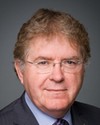Thank you, Mr. Chair, and thank you, Colonel Drover, for coming.
Here is just one little correction to my colleague Mr. Simms. It's airmen and airwomen, not soldiers, who man the aircraft and do the SAR work. Forgive my air force roots on that point.
Colonel Drover, it was suggested by Mr. Harris that some people might have a bigger SAR area of responsibility than we have. I'm not aware of anybody who does. Does anybody have a larger AOR than Canada?



